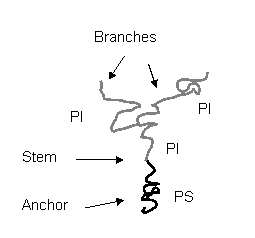Juan Pablo Hinestrosa1, Masashi Osa2, Kunlun Hong3, Jimmy W. Mays4, and S. Michael Kilbey II4. (1) Chemical and Biomolecular Engineering, Clemson University, Clemson, SC 29634, (2) Department of Polymer Chemistry, Kyoto University, Kyoto, Japan, (3) Center for Nanophase Materials Science, Oak Ridge National Laboratory, Oak Ridge, TN 37381, (4) Center for Nanophase Materials Sciences and Chemical Science Division, Oak Ridge National Laboratory, Oak Ridge, TN 37831
Solution properties, adsorption and interfacial layer structure of self-organized polystyrene-polyisoprene miktoarm block copolymers
Juan Pablo Hinestrosa, Masashi Osa, Kunlun Hong, Jimmy Mays and S. Micheal Kilbey, II
We have studied the self-assembly at the solid/liquid interface of a set of novel polystyrene (PS) – polyisoprene (PI) block copolymers having a branched architecture in solution and at the solid/liquid interface. Miktoarm (mixed arm) copolymers having a linear PS block connected to a ‘star-like' PI-(PI)2 branched block were synthesized by rigorous anionic polymerization (Figure 1). Their solution properties have been studied by static and dynamic light scattering in n-hexane, which is selective for PI. The results suggest that in solution, these novel block copolymers aggregate into spherical ‘hairy' micellar structures with the core being composed of the collapsed linear PS blocks and the corona formed by the well-solvated PI blocks. A PS-PI diblock linear copolymer of similar molecular weight and composition showed larger values of apparent hydrodynamic radius, Rh, app, which is consistent with the idea that branched polymers have more compact structure compared to their linear analogs. Atomic Force Microscopy was used to study the morphology of the adsorbed structures. The images show round features that might be attributed to hemispherical micellar aggregates on the surface caused by a micellar relaxation/reorganization process upon adsorption. This conclusion agrees with results from phase modulated ellipsometry studies of adsorption kinetics. By using a model developed for the adsorption of lipid bilayers and vesicle fusion, the self-assembly process of the miktoarm stars onto silicon can be fully characterized proving insights in how these novel block copolymers reorganize at the solid/fluid interface. Technological areas such as deposition of inorganic nanoparticles and control of protein adsorption will be benefited from these fundamental studies.
SHAPE \* MERGEFORMAT 
Figure 1. Illustration of a PS-PI-(PI)2 Miktoarm Copolymer Single Chain
